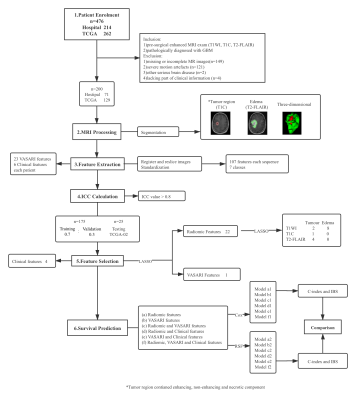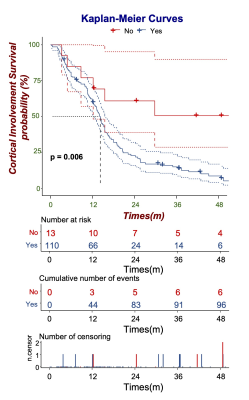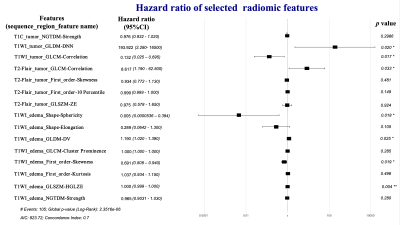3496
A Comparative and Summative Study of Radiomics-Based Overall Survival Prediction in Glioblastoma Patients1Shanghai Institute of Medical Imaging, Fudan University, Shanghai, China, 2Department of Radiology, Huashan Hospital Fudan University, Shanghai, China, 3Department of Pathology, Huashan Hospital Fudan University, Shanghai, China, 4GE Healthcare, MR Research China, Shanghai, China, 5Department of Radiology, Shanghai Cancer Center, Fudan University, Shanghai, China
Synopsis
The prediction of overall survival in glioblastoma patients can provide great aid to clinical treatment. Therefore, we extracted clinical, VASARI and radiomic features from pre-operative MRI scannings and compared the predictive capacity of Cox algorithm and random forest based on these features. According to our results, tumor without cortical involvement had longer overall survival than those involved; the random forest models outperformed Cox regression models in general and the random forest model consisting of radiomic features was the best one. Ten radiomic features were reproducible in our and other’s studies exhibiting promising value in overall survival prediction of glioblastoma.
Purpose
To establish different models composed of magnetic resonance imaging (MRI) radiomic features, Visually Accessible Rembrandt Images (VASARI) features and clinical characteristics, and to compare their capacities to predict the overall survival (OS) of glioblastoma (GBM) by machine learning.Methods
Patients diagnosed with GBM from our institution and TCGA database were divided into three databases (training, validation and independent testing sets). The process mainly consists of four parts (Figure 1):1. Image pre-procession and tumor segmentation. For each image, the tumor region of interest (ROI) can be delineated by ITK-SNAP software.
2. VASARI evaluation. Each patient was assessed on the basis of its response criteria and consensus scores.
3. Feature extraction. Tumor and edema features from MRI sequences were extracted in succession by the ‘Radiomics’ extension in 3D Slicer software.
4. Radiomic feature selection and model building. Radiomic features were selected by two-step Least Absolute Shrinkage and Selection Operator (LASSO) 1 in R software (version 3.6.1). After combing selected clinical, VASARI and radiomic features, 12 survival models were constructed by RSF and Cox algorithms sequentially.
Results
One VASARI and 15 radiomic features were selected (Figure 2 and Figure 3). Those cases with cortical involvement had shorter survival time (Figure 2, p = 0.006). In general, RSF classifiers showed higher C-index of testing set compared with Cox classifier, and the RSF model based on the radiomic features was the most optimal one to predict OS (C-index of testing set, 0.935±0.023, Figure 4).Discussion
In our study, only cortical involvement from VASARI features was identified to be highly related to OS, with the non-enhancing or enhancing tumors extending to the cerebral cortex, patients were more likely to have shorter survival time (figure 2). Also, Jung k C et al found GBMs with cortical involvement were prone to recur in the distance and become multifocal2, which had worse outcomes compared to unifocal lesions. Fifteen radiomic features were selected to be associated with OS by two-step LASSO in our study (Figure 3). Nevertheless, there was no significant features related to survival time from tumor region in T1C, which may result from the different delineation means of tumor region between our study and the others3,4. We searched and reviewed 16 radiomics-based GBM-OS prediction articles until 2019 to better compare our study and the others. Regardless of sequence and region, 10 out of 15 selected radiomic features in our study were aligned with the selected radiomic features in other studies which hinted the reliability of these features. After comparing the models in our study, RSF model of radiomic features achieved the highest C-index in testing set (C-index: 0.935±0.023), and the IBS values in validation and testing sets were close. It implied that the prediction ability of RSF model was more accurate, which could reduce diagnostic errors. These findings were aligned with some previous work5,6.Conclusion
The cortical involvement according to VASARI showed promising prediction value for GBM OS. The RSF models outperformed Cox regression analysis in general, and the RSF model built by radiomic features achieved the highest OS prediction efficiency in GBM. In addition, the identical ten radiomic features in our and others’ studies illustrating potential in OS prediction of GBMs.Acknowledgements
This work was supported by the Science and Technology Commission of Shanghai Municipality [Grant No. 18ZR1405700]; the Shanghai Municipal Science and Technology Major Project [No. 2018SHZDZX01] and ZJ Lab.References
[1] Tibshirani R. Regression shrinkage and selection via the Lasso. J R Stat Soc Ser B-Methodological. 1996;58(1):267–88.
[2] Jungk C, Warta R, Mock A, Friauf S, Hug B, Capper D, et al. Location-dependent patient outcome and recurrence patterns in IDH1-wildtype glioblastoma. Cancers (Basel). 2019;11(1):17.
[3] Bae S, Choi YS, Ahn SS, Chang JH, Kang SG, Kim EH, et al. Radiomic MRI phenotyping of glioblastoma: improving survival prediction. Radiology. 2018;289(3):797–806.
[4] Chaddad A, Desrosiers C, Toews M. Radiomic analysis of multi-contrast brain MRI for the prediction of survival in patients with glioblastoma multiforme. Conf Proc IEEE Eng Med Biol Soc. 2016; 2016: 4035–8.
[5] Kim DW, Lee S, Kwon SM, Nam W, Cha IH, Kim HJ. Deep learning-based survival prediction of oral cancer patients. Sci Rep. 2019; 9:10.
[6] Segar MW, Vaduganathan M, Patel K V, McGuire DK, Butler J, Fonarow GC, et al. Machine learning to predict the risk of incident heart failure hospitalization among patients with diabetes: the WATCH-DM risk score. Diabetes Care. 2019;42(12):2298–306.



